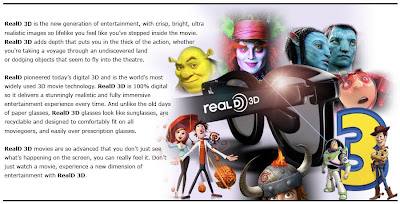

From the RealD Website:
"We are a leading global licensor of stereoscopic (three-dimensional), or 3D, technologies. Our extensive intellectual property portfolio enables a premium 3D viewing experience in the theater, the home and elsewhere.
We license our RealD Cinema Systems to motion picture exhibitors that show 3D motion pictures and alternative 3D content. We also provide our RealD Format, active and passive eyewear, and display and gaming technologies to consumer electronics manufacturers and content producers and distributors to enable the delivery and viewing of 3D content on high definition televisions, laptops and other displays. Our cutting-edge 3D technologies have been used for applications such as piloting the Mars Rover, heads-up displays for military jets and robotic medical procedures."














